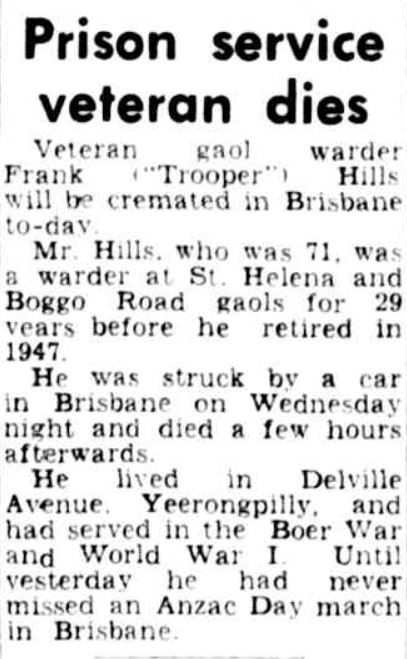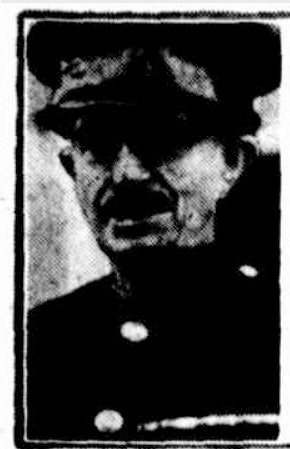Officer – Frank “Trooper” Hills
- On : 21 September, 2018
- By : Boggo Road Gaol
- Category : Stories
- View : 1949
Frank “Trooper” Hills
Frank “Trooper” Hills – Boer War and Gallipoli veteran serves 25 years in Boggo Road Gaol. Not how you think, he was an officer and a gentleman.
Frank Hills, known to everyone as “Trooper”, was born in Brighton, England to William Nash Hills and Fanny Morell.
His nickname “Trooper” was gained through his extensive military career in the Australian Light Horse. He served his country with pride, from the Boer War through to the end of the first world war with only a few days between deployments. He was twice wounded at Gallipoli, rapidly rising through the ranks as the 9th Infantry arrived at Gallipoli. On enlistment he was a private, two days later promoted to Corporal, and three days later again to Sergeant. As the history books tell us, Gallipoli was a terrible campaign with a tragic loss of life. The army needed good experienced soldiers to lead their young men into battle, I suppose this is how trooper got promoted so quickly, a little older at almost 32, with his experience it is little surprise the promotions happened as they did. Less than a year later he was promoted to Company Sergeant Major, and eventually temporary Regiment Sergeant Major.
Next the campaign would take “Trooper” to France. Where again he was wounded. Dispatched to England for medical treatment he would return to the front a few weeks later after some rest. Finally transferred home in 1918 as part of a unit to guard submarine bases in Sydney.
Prison Service
“Trooper” joined the prison service as a probationary warder on the 4th of April 1919, just one month after being discharged from the Army. First posted to St Helena, he was involved in several prisoner related problems. One fellow warder being slashed in the throat with a knife.
“Trooper” then later moved to Boggo Road Gaol where he would serve the remainder of his 29 years in the service. “Trooper” kept his head down and was a good prison officer, he had great consideration for his fellow man and when interviewed after his retirement he would talk about the times of prisoners at the gaol and believed that the majority of men under his care were merely victims of circumstance. Of course there were some “Bad Eggs” he said.
Perhaps the most interesting and sensational time of Trooper’s career at Boggo Road was the discovery of the Cyanide Plot of 1940. A prisoner William Edward Langford smuggled a deadly vial of Cyanide under his armpit into Boggo Road Gaol. It only being discovered on a pat down search of the prisoner before putting him in his cell. The prisoner shouted for the warders “For god sake tell that man not to open that vial and smell it – it will knock him _____ out”. It was soon discovered that the vial contained enough Cyanide to kill 50 people. The 
Retirement
“Trooper” would retire in 1947 to his home in Yeerongpilly with his wife, Helen. Throughout all of the years after returning home from the war, he never once missed an Anzac Day service. Tragically, on the 23rd of April 1952, while crossing the street. “Trooper” Hills was struck by a car and died in the Brisbane General Hospital just a few hours later, he was 67. Anzac Day 1952 would be the only one he ever missed. He was cremated at Mt Thompson crematorium on the 26th of April 1952, his ashes laid to rest with his wife who survived him by just six years.
Want to know what it was like to be an officer at Boggo Road Gaol? Come along this Sunday for our officer tour and meet former officer Kevin Hayden! For more information click here
This article was contributed by Research Coordinator Sue Olsen as part of the ongoing research program for Boggo Road Gaol Pty Ltd. The aim of the program is to bring to light and share articles relating to Boggo Road for the purposes of review and study. Do you have a story to share or something you would like us to know about? You can contact the research team here.



